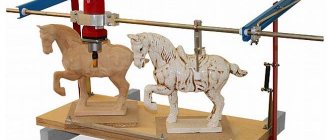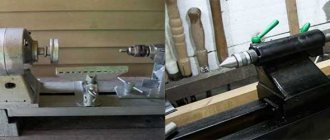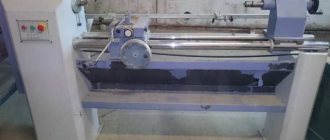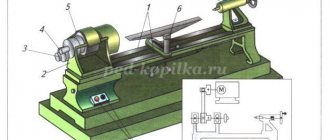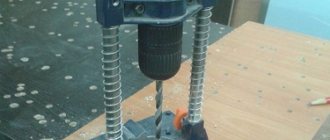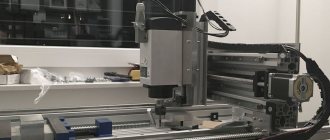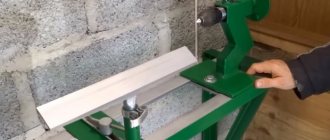Classification of lathes
Many people decide to buy and install lathes in their own workshop because of their possible use in the manufacture of cylindrical products. There are quite a large number of different models; they can be divided into several groups:
- Classic equipment, when the workpiece is located in a chuck or faceplate. A cutter is used as a cutting tool. The workpiece can rotate at different speeds. However, the equipment is not suitable for mass production.
- Copying machines can be used to work from a template. By using a template, you can simplify the task of manufacturing similar products. For small-scale production, a manually operated machine is suitable, as it is low cost and easy to use.
- Milling machines are extremely common today. This is due to the fact that they are widely used in the production of cabinet and flat parts made of wood and metal. There is also a wood turning and milling machine, which can be used to perform various operations.
- Models with numerical control. In mass production or the manufacture of expensive products, equipment that has a CNC unit can be used. However, the use of a copier significantly reduces the cost of the product.
The copying device for a wood lathe has very attractive characteristics, due to which they began to be installed in private and other workshops.
Tools, actions with them
They begin work by marking the sections of the corner and channel for the frame; To do this, use a tape measure or marker; for drawing perpendicular cutting lines - a square. Using a grinder, cut parts to the required length.
An abrasive wheel is used to remove rust and dirt from the surface of parts along the joints to improve the quality of the weld.
- On the welding table, the workpieces are placed in the required configuration, the value of the right angle is controlled, and they are pressed to the surface with clamps.
- Boil the joint on both sides and repeat the operation for all joints. Use a grinder with an abrasive stone to clean and level the weld seams.
- On the finished frame, markings are made for mounting the engine, and with a punch, recesses are made in the place of future holes.
Using a drill, holes are drilled first with a drill of small diameter (3-4 mm), then with a large one (9-10 mm). The tool rest is made with the same tools. To manufacture some parts of the headstock and tailstock, a metal lathe is required.
It’s easier to order a shaft, thrust cone, and bearing housings from a professional turner. You can simplify the tailstock to the limit: use a long screw with a conical point.
The copier is made from plywood. A marker is used to mark the profile line of the future product, and a cut is made along it with a jigsaw.
- The copier is mounted at the level of the tool rest. A limiter is installed on the turning cutter, moving along the edge of the copier.
- Wooden pulleys for a drive with a belt drive are made like this: a disk of the required diameter is cut out of a hardwood board and placed on the motor shaft.
A temporary tool is prepared, the engine is secured, started, and a pulley is machined on it. It will be accurate and balanced.
Classic design
Industrial machines have a rather complex design, especially CNC versions, which can carry out processing automatically. The required product can also be obtained using copying equipment. The classic design is represented by a combination of the following main components:
- The bed acts as a base and connecting element. The structure is made using metal, the individual elements are connected by welding. The bed can have different heights. Each craftsman chooses his own height when making a homemade structure.
- The headstock and tailstock are also an integral part of the machine. The headstock is used to house the gearbox and drive, as well as the electric motor. The tailstock is used to fix the workpiece, which makes it possible to produce longer products.
- The main rotation is received by the workpiece. It is transmitted from an electric motor through a drive.
- The tool rest also allows for high-quality processing. It is worth securing the cutting area to eliminate the possibility of injury to your hands or contact with a foreign element.
- Leading and driven centers used to secure the workpiece.
A homemade copier for a wood lathe also allows for high-quality processing of workpieces.
DIY making
Industrial versions of machines are expensive. That is why many are considering the possibility of assembling the machine with their own hands. Recommendations for carrying out the work are as follows:
- First, you should develop or download a drawing according to which the assembly will be carried out. As a rule, a drawing of a conventional lathe is taken, which is modified to accommodate the installation of a copier.
- Work begins with the creation of the bed. This will require corners, as well as sheets of metal. The connection of individual elements is carried out using a welding machine. It is worth considering that screw connections are characterized by less rigidity. The bed must be strong and resistant to vibration.
- The main component is the electric motor. In order to increase the functionality of the equipment, an electric motor with a power of 200-250 W at 1500 rpm is installed. If you plan to process large workpieces, then a more powerful motor is installed. The motor should be protected from environmental influences.
- To fix the workpiece, a faceplate is attached to the output shaft. It has several sharp elements that it hits. Due to the sharp elements, rotation is transmitted, but fixation is carried out due to the tailstock with centers.
Most attention is paid to the production of the copier. This is what distinguishes a lathe from a copying machine.
Creating a copier
The copier is used to produce similar products. Due to its use, the productivity indicator is significantly increased. Among the features associated with creating a copier, the following points are noted:
- The basis for this unit is an unnecessary manual router.
- To position the copier, a platform measuring 20 by 50 cm is used. To secure the device, holes are created and bars are installed.
- To ensure processing along the entire length of the workpiece, the platform must move along the entire bed.
- The bars are fastened using self-tapping screws. They provide reliable fastening of the device.
- When performing work, you should use a level, since even a slight deviation from the horizontal position will lead to significant errors.
- The lathe places the block in a horizontal position. This is where the template will be attached. The timber is also fastened using self-tapping screws.
- The design is created in such a way that, if necessary, you can remove the copier and use the machine as regular lathe equipment.
The template is made of plywood and is screwed to the front surface of the beam. The upper surface of the previously installed beam is aligned with the axis of the template.
Disadvantages of the device in question
A homemade copying machine has a fairly large number of significant disadvantages. An example is the following information:
- Two hands are required to move the surface with the milling mechanism. This is due to the fact that the moving element is poorly fixed; you have to move it with both hands. If errors are made during the production of the structure, the moving element may warp and jam.
- To increase the processing accuracy, a screw gear is installed.
- The copier is suitable for making extremely simple products. An example is that it will be impossible to repeat twisted patterns on posts when using such a machine.
- You can increase the versatility of the device by replacing the circular cutter.
That is why it is recommended to install industrial machines to establish the production of complex wooden elements.
Do-it-yourself lathe copier (copying lathe)
Making a lathe copy with your own hands is not the most difficult task. But in order to achieve the desired result in terms of quality and efficiency, you will have to make some efforts. You will need a detailed drawing, a copy template and several hours of free time. We offer you a version of a copier machine based on a hand milling cutter as a cutting tool.
Photo of a lathe copier with your own hands
The proposed copier for your lathe requires little financial, time and labor costs. This is why it attracts a large number of craftsmen who need a copier for a lathe.
The cutting device will be a hand router. At the same time, the operational capabilities of the copier directly depend on the characteristics of the turning equipment itself.
You should not count on the attractiveness of the design of a device you create yourself, since its main task is to create copies according to a template without unnecessary energy consumption.
The device of the machine with a copier
DIY lathe copier drawing
- To begin with, to create a lathe with a tracer, you will need a hand router. Choose its type yourself, depending on the planned work;
- The router is mounted on a support platform with dimensions of approximately 50 by 20 centimeters. It can be made from 12 mm thick plywood sheets;
- At your request, the copying machine can have a larger or smaller platform. The dimensions largely depend on the parameters of the selected router;
- On the support platform, make holes through which the routers will come out;
- Holes for fastenings are also made here. It is optimal to use bolts as fasteners;
- Thrust bars located around the perimeter and fixed with self-tapping screws will provide protection against accidental movements of the cutter when processing products;
- Having installed the cutter support between the bars, make sure that it is securely fixed and there is no vibration or play;
- The far end of the support platform must be able to move along the guide pipe along the entire length of the turning equipment;
- Use a guide pipe with a diameter of 25 millimeters, or adapt it to your machine parameters;
- The main condition when choosing pipes is that they must cope with the loads from the weight of the router, not sag, and maintain an even, smooth surface;
- Secure the ends of the pipes with a pair of wooden blocks of a suitable size;
- The bars are mounted to the machine body with self-tapping screws or through bolts.
Installation of structural elements
In order for the lathe with a copier to work efficiently, and the copying process does not raise quality issues, do not rush in any case. It is precisely the rush that prevents craftsmen from making a really good copier for a lathe with their own hands.
Having studied the drawing on the basis of which you decided to build a copier with your own hands, stick to the suggested dimensions. If you make even a small error, the copying technology may be completely disrupted and the working axes may be disrupted.
To prevent anything like this from happening, follow a few important rules.
- The axis of the pipe intended for moving the router must be exactly parallel to the axis of rotation of the machine.
- The coincidence of the pipe axis and the machine axis is also an important plus, although this condition is not mandatory.
- The main point is the coincidence of the milling cutter in the lowest position with the axis of the turning device. This parameter is controlled and changed as necessary due to the level of placement of the copier.
- Fix the guide pipe through the blind holes of the wooden blocks. But immediately before fixing, place two bars on the pipe on which you plan to install the supporting platform.
- The wooden blocks for the load-bearing platform must move very easily, or rather slide along the guide pipe. If loosening is noticed, the copying unit will have to be redone.
Many fear the moment when increased demands are placed on gliding. But making a machine with such operating parameters is not difficult if you use an even, smooth pipe.
Horizontal bars
The next step is to install the horizontal block of wood, which is the second most important operating component of your tracer lathe.
- Adhere to similar precision requirements as in the operations described above;
- The horizontal beam is connected to the workpiece profile template;
- To make a block with your own hands, you can use a workpiece measuring 7 by 3 millimeters and fix it with self-tapping screws to the vertical posts;
- The wooden stands themselves are mounted to the lathe bed using any method convenient for you;
- Make sure that the top edge of the horizontal element is parallel to the axis of the machine and is located at the same level;
- If at some point you don’t need the copying functionality, you can easily remove the block with your own hands, fold the mounting platform onto the edge of the machine and use the turning unit for its intended purpose without a copier;
- A vertical stop is mounted to the milling table. A sheet of thin plywood is quite suitable here. Although if you require a more durable structure, use steel sheets;
- This element is used to move around the copier when sharpening parts. It sets the spatial position for the working milling cutter. Therefore, the copier should be fixed as securely as possible;
- Thickness plays an important role. The thinner the vertical stop is, the more accurately the lathe can copy your template. But even if the stop is too thin, the device begins to move according to the pattern with certain difficulties. Therefore, the optimal way out of the situation is to find an intermediate option;
- If you use plywood to make a copier, be sure to consider using a removable design. This will allow you to easily dismantle the copier when it wears out and replace it with a new one with minimal time investment.
Sample
The last but not least important element of a lathe with a copier function is the copy template itself. It is not difficult to make, but the configuration completely depends on the parameters of the products that you want to obtain using your machine.
Here are some simple recommendations regarding the presented version of the lathe with a copier:
- Take a sheet of plywood or OSB board;
- Apply markings on the sheet according to the contours of the future product that you want to turn on a lathe;
- Be sure to compare all dimensions with the required parameters;
- Use an electric jigsaw to carefully cut the blade along the contours, cutting out the required part;
- Sand the edges with a sander or regular sandpaper. The template should not have any irregularities, burrs or nicks;
- Secure the resulting template to the horizontal rail using self-tapping screws;
- Carry out fixation strictly in accordance with the installation parameters.
Using drawings and video instructions, you can easily make a fairly efficient, productive copy lathe unit yourself. You just need a little patience and time.
Article rating - material rating: 4.00 out of 5 Loading…
tvoistanok.ru
Wood cutting machine Proma DSL-1200
The model in question is intended for processing wooden products that can be used as decorative elements. Experts call a distinctive feature of the design the presence of two incisors:
- The first is designed for processing cylindrical workpieces; more than 10 mm can be removed in one pass. Using the first cutter, you can get a round workpiece, just like on a conventional lathe.
- The second cutter is designed for copier work. It is this that allows you to produce various products using a copier.
This machine model can be used to work with large workpieces. To do this, the structure is equipped with a steady rest, which is mounted on rods that act as guides. The installed faceplate allows processing multi-faceted products.
Main characteristics of the model:
- The installed electric motor operates from a three-phase network with a voltage of 380 V. That is why the machine is not purchased for installation in a private workshop.
- The maximum length of the workpiece is 1200 mm.
- The layout is represented by a combination of two columns, between which the workpiece is placed. Note that the machine has a compact size, due to which it does not take up much space in the workshop.
The disadvantage of this proposal, like many others, is the rather high cost.
Copy model CL-1201
To produce wood products, a machine model CL-1201 or CL-1500b can be used. The first version has very attractive performance characteristics:
- The spindle used can change the direction of rotation. Due to this, the scope of application of the model is significantly expanded. Changing the direction of rotation of the spindle is carried out with a special handle.
- The machine allows you to select the spindle rotation speed with high precision. Due to this, it is possible to provide the most favorable conditions for turning wood based on the weight, dimensions and type of wood.
- There is a remote control to set basic parameters. The design can be installed on the headstock or tailstock, depending on the preference of the master. The remote control is represented by a combination of several keys.
- Cast iron is used in the manufacture of the column. In addition, the frame is manufactured using high-quality steel. By combining these materials, the degree of vibration of the structure during operation is reduced.
- The basic delivery includes a copier, which can be used for processing. Due to this, costs are reduced and the machine becomes more functional in use.
- The design of the machine has a milling attachment, which can be used to produce longitudinal grooves.
- The tailstock is used for more precise fixation of the workpiece. Its position may also change. The supply includes centers, which are selected depending on the characteristics of the workpiece.
- The support is characterized by high mobility. The cutting depth of the tool can be adjusted using a lever.
In addition, the manufacturer paid quite a lot of attention to the degree of protection of the machine from environmental influences. For example, the engine has a protection system against overheating or overload, all electronic parts are also protected from moisture and dust.
The only but significant drawback is the high cost of the proposal. A homemade design will cost several times less.
